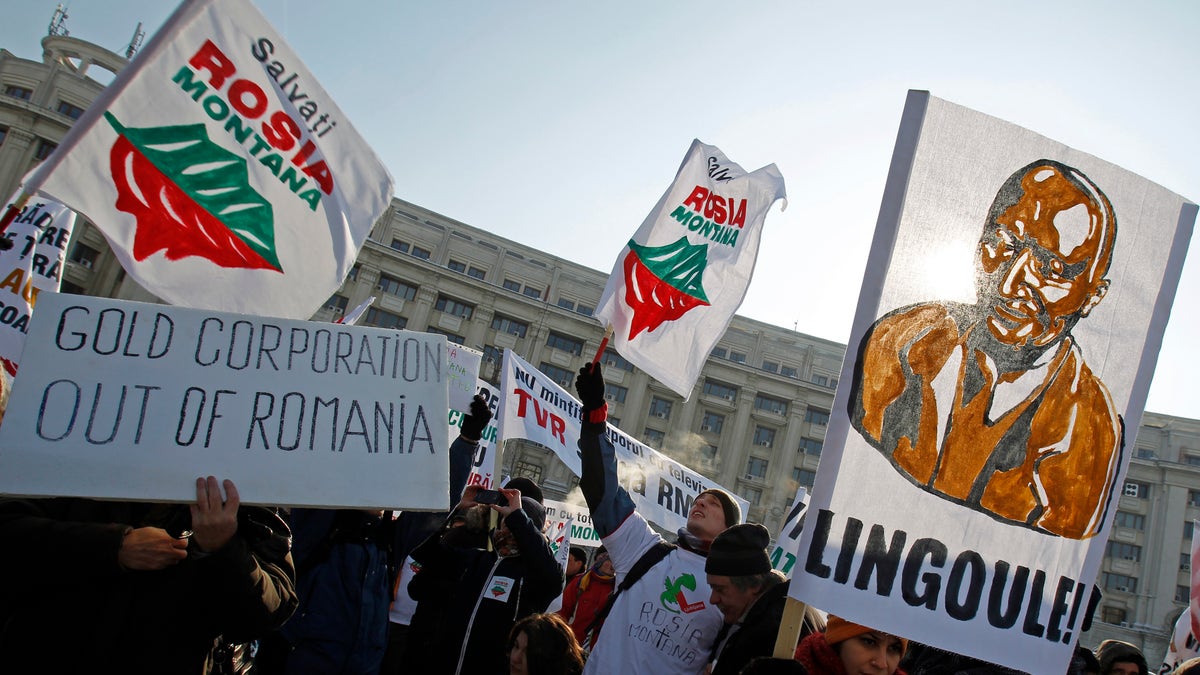
January 28, 2012 - FILE photo of demonstrators waving flags that read "Save Rosia Montana" and a banner depicting a gold figurine of Romania's President Traian Basescu, an open supporter of the gold mine project, during a protest in front of the Parliament palace in central Bucharest. Hundreds of Romanians protested against a plan to set up Europe's biggest open-cast gold mine in the western Romanian town of Rosia Montana. (AP)
A leaked report revealing the archaeological significance of an ancient Roman gold mine in Romania is reigniting a battle between profit seekers who want to exploit the area, and historians and environmentalists trying to preserve the cultural wonder.
The British report by archaeology experts has caused the Romanian government to halt its plans to approve invasive mining at the site, according to a report in the British newspaper, the Independent.
The Bucharest government had kept the report under wraps for three years. It was commissioned by Romania’s ministry of culture and funded by the non-profit organization Pro Patrimonio, which works to protect the country’s cultural heritage.
The ancient site in Rosia Montana, in the Apuseni Mountains of western Transylvania, should be considered as a world heritage site by UNESCO, according to the report, which describes the spot as “the most extensive and most important underground Roman gold mine known anywhere."
The ministry of culture released a list of monuments this month that it would like identified as world heritage sites, but Rosia Montana was not included.
While preservationists see the mine as an opportunity to learn about ancient culture, fortune hunters see dollar signs. The village is located near one of the largest undeveloped gold deposits. Canadian mining company Gabriel Resources wants to dig for gold, which would threaten surrounding villages and mountains, and could involve the use of 40 tons of cyanide daily.
Despite the environmental risks involved, Rosia Montana’s mayor, Eugen Furdui, supports the mining plans. "If Rosia Montana were added to the UNESCO World Heritage list, that would automatically mean that mining [could not] go through. And we want this mining project to be carried on,” Furdui said in 2010.
The report's authors -- Andrew Wilson and David Mattingly, professors of Roman archeology at Oxford University and Leicester University respectively -- teamed up with Mike Dawson, director of archaeology at an environmental consulting firm, to travel to Romania, and were impressed by the mine.
"The key thing we were asked to do was to evaluate the site and see if it was a worthy consideration to be a UNESCO World Heritage site," Dawson said. "Our opinion is that it has a very high status."
After the report was leaked, a government commission rejected the mining proposal, but opponents warn the stay is only temporary, as the rejection was based on technical and legislative reasons rather than environmental.
Hundreds of thousands of protesters have demanded the Romanian government drop legislation that would have enabled Gabriel Resources to proceed with the project.
"I am glad the public [can now see] that information," Dawson said. "It deserves to be out there."
Gabriel Resources and other potential gold diggers have the opportunity to submit revised mining proposals. "Our goal remains to bring the project through to a reality that will significantly benefit Romania and Rosia Montana,” offered Jonathan Henry, Gabriel chief executive.
Now that the report is out, it will be challenging for the Romanian government to deny the mine’s cultural significance. But the lure of gold in them hills is strong.
"In my experience, money talks," Dawson said. "If [the report] is criticized, it will be criticized on the basis that conservation costs money."
